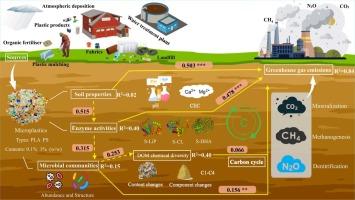可生物降解和不可生物降解的微塑料通过化学多样性和微生物多样性影响温室气体排放
IF 11.3
1区 环境科学与生态学
Q1 ENGINEERING, ENVIRONMENTAL
引用次数: 0
摘要
虽然土壤微塑料(MPs)的环境风险已经确定,但它们作为外源碳源在推动温室气体(GHG)排放中的作用仍然知之甚少。特别是,可生物降解和不可生物降解微塑料通过微生物群落变化和土壤有机碳(SOC)化学成分影响温室气体排放的机制尚不清楚。为了解决这个问题,本研究调查了两种微塑料——可生物降解聚乳酸(PLA)和不可生物降解聚苯乙烯(PS),在0.1%或1% (w/w)的浓度下对土壤性质、碳相关酶活性、温室气体排放和微生物/化学多样性的影响。PLA的添加显著提高了有机碳和溶解有机质(DOM)含量。微塑料刺激了木质素过氧化物酶和纤维素酶的活性,并改变了微生物组成:在门水平上,变形杆菌、酸杆菌和放线菌的丰度发生了变化;在属水平上,维氏菌门、维氏菌科和鞘单胞菌发生了变化。在1% PLA和PS处理下,高分子量芳香族化合物含量增加。微塑料增加了CO₂和N₂O的排放量,但对CH₄没有影响。分段结构方程模型显示,温室气体排放与化学多样性(R²=0.45)和微生物多样性(R²=0.15)相关。我们的研究结果阐明了微塑料诱导的碳转化、微生物活动和温室气体排放之间的机制联系,突出了可生物降解微塑料与传统微塑料对土壤-气候反馈的不同影响。本文章由计算机程序翻译,如有差异,请以英文原文为准。

Biodegradable and Non-biodegradable Microplastics affect Greenhouse Gas Emissions through Chemical Diversity and Microbial Biodiversity
While the environmental risks of soil microplastics (MPs) are well-established, their roles as exogenous carbon sources in driving greenhouse gas (GHG) emissions remain poorly understood. Particularly, the mechanisms by which biodegradable and non-biodegradable microplastics influence GHG emissions through microbial community shifts and soil organic carbon (SOC) chemical composition are unclear. To address this, this study investigated the impacts of two microplastics - biodegradable polylactic acid (PLA) and non-biodegradable polystyrene (PS), applied at 0.1% or 1% (w/w), on soil properties, carbon-related enzyme activities, GHG emissions, and microbial/chemical diversity. PLA addition significantly increased SOC and dissolved organic matter (DOM) content. Both microplastics stimulated lignin peroxidase and cellulase activities and shifted microbial composition: at the phylum level, Proteobacteria, Acidobacteriota, and Actinobacteria abundances changed; at the genus level, Vicinamibacterales, Vicinamibacteraceae, and Sphingomonas were altered. High-molecular-weight aromatic compounds increased under 1% PLA and PS treatments. Microplastics elevated CO₂ and N₂O emissions but did not affect CH₄. Piecewise structural equation modeling revealed that GHG emissions correlated with chemical diversity (R²=0.45) and microbial diversity (R²=0.15). Our findings elucidate mechanistic links between microplastics-induced carbon transformation, microbial activity, and GHG emissions, highlighting distinct impacts of biodegradable versus conventional microplastics on soil-climate feedbacks.
求助全文
通过发布文献求助,成功后即可免费获取论文全文。
去求助
来源期刊

Journal of Hazardous Materials
工程技术-工程:环境
CiteScore
25.40
自引率
5.90%
发文量
3059
审稿时长
58 days
期刊介绍:
The Journal of Hazardous Materials serves as a global platform for promoting cutting-edge research in the field of Environmental Science and Engineering. Our publication features a wide range of articles, including full-length research papers, review articles, and perspectives, with the aim of enhancing our understanding of the dangers and risks associated with various materials concerning public health and the environment. It is important to note that the term "environmental contaminants" refers specifically to substances that pose hazardous effects through contamination, while excluding those that do not have such impacts on the environment or human health. Moreover, we emphasize the distinction between wastes and hazardous materials in order to provide further clarity on the scope of the journal. We have a keen interest in exploring specific compounds and microbial agents that have adverse effects on the environment.
 求助内容:
求助内容: 应助结果提醒方式:
应助结果提醒方式:


